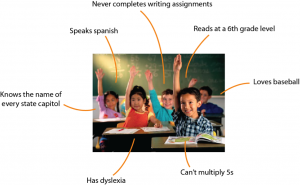 All students have unique strengths, experiences, and interests. Some may be excellent at algebra while others struggle with basic computation. Some may be incredibly gifted in the creative arts while others thrive in understanding logic. For centuries the industrial education model has limited our ability to tailor educational experiences to the needs of each individual learner. A teachers in a classroom of 20-30 students has little choice but to teach everyone the same way at the same time. With few exceptions all students work on the same topic at the same time and do the same activities as the other students in the class. Students progress to the next learning activity based on the schedule rather than on demonstrated mastery of the concept. At the end of a unit students who are still struggling will have to move onto the next unit even if they aren’t ready. At the same time, students who already understand the concept will have to sit through the learning activity even though they are ready to move onto the next concept. In a sense, the traditional model keeps the schedule constant at the cost of allowing the learning to vary.
All students have unique strengths, experiences, and interests. Some may be excellent at algebra while others struggle with basic computation. Some may be incredibly gifted in the creative arts while others thrive in understanding logic. For centuries the industrial education model has limited our ability to tailor educational experiences to the needs of each individual learner. A teachers in a classroom of 20-30 students has little choice but to teach everyone the same way at the same time. With few exceptions all students work on the same topic at the same time and do the same activities as the other students in the class. Students progress to the next learning activity based on the schedule rather than on demonstrated mastery of the concept. At the end of a unit students who are still struggling will have to move onto the next unit even if they aren’t ready. At the same time, students who already understand the concept will have to sit through the learning activity even though they are ready to move onto the next concept. In a sense, the traditional model keeps the schedule constant at the cost of allowing the learning to vary.
Generally conceptualized as tailoring learning experiences to meet individual students’ needs and interest, personalized learning moves beyond the industrial one-size-fits-all schooling to a model that recognizes that all students have different strengths and challenges. Personalized learning as a concept is not is not new. Many of the elements of personalization have been discussed for decades and even centuries. The ideas of personalization can be found in the writings of 18th century philosopher Rousseau as well as in those of early 20th century educational leaders such as Dewey and Montessori. Personalization has also been the fundamental requirement of the Individuals with Disabilities Act (IDEA) for nearly 40 years. But personalizing at scale (for all students) has until recently remained an elusive goal, largely due to the time intensiveness required to provide individual instruction to all students.
Fortunately, recent developments in educational technology have ushered in new tools to support personalized learning. Educators are looking to personalized learning as a way to address persistent learning challenges, such as achievement gaps and student disengagement, that have long plagued our education system.
Defining Personalized Learning
Personalized learning refers to learning experiences in which the pace and the approach are adjusted to meet the needs of individual students and in which the learning is tied to students’ interests and experiences. The formal definition of personalized learning provided by the U.S. Department of Education in the 2016 National Ed Tech Plan is:
“Personalized learning refers to instruction in which the pace of learning and the instructional approach are optimized for the needs of each learner. Learning objectives, instructional approaches, and instructional content (and its sequencing) all may vary based on learner needs. In addition, learning activities are meaningful and relevant to learners, driven by their interests, and often self-initiated.”
In other words, personalized learning includes pieces of all of the four approaches listed below, along with an element of learner agency (i.e., students are involved, in some degree, in the decision-making process related to their learning). When implemented correctly, personalized learning experiences will feel relevant to students based on their instructional needs and personal interests.
There are a number of schools where personalized learning is underway. Among the most recognized are Lindsay Unified and Summit Public Schools.
Additional Resources
LEAP Personalized Learning Framework